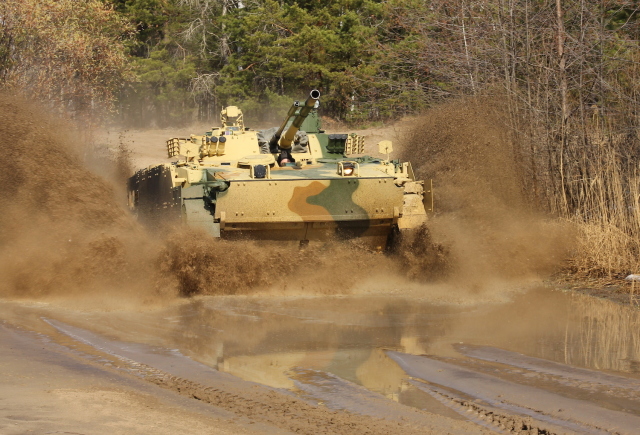IFVs designed to transport personnel and fire support are a relatively young class of combat vehicles that appeared in the 1960s. However, several generations of this technique have already changed over the past time. All these years, the only developer and manufacturer of light-weight infantry fighting vehicles in our country was the Kurganmashzavod of the High-Precision Complexes holding. In 2020, the general public got acquainted with the newest model – the Manul BMP, work on which is still underway, taking into account the operation of armored vehicles during the SVO.
About the features of this class of equipment and its prospects – in our material.
A new word in armored vehicles
With the development of mechanized troops and tank weapons, the question arose about new means of transporting infantry and cargo – well-protected and armed, maneuverable and passable. So, in the second half of the 1940s, the USSR had its first armored personnel carriers (APCs), mainly on a wheelbase.
However, already in the mid-1950s there was a real threat of the use of weapons of mass destruction (WMD). Then it becomes clear that between the tank and the APC, another type of armored vehicles is needed, which can not only transport infantry, protecting it on the road, but also support the offensive with powerful fire. Armored personnel carriers, often not armed with a stationary gun, remained, in fact, only transport, whose task was to deliver as many motorized infantry to their destination as possible. And already on the battlefield, the personnel had to go under the cover of tanks or ride them, as during the Great Patriotic War, which in the conditions of the use of WMD was fraught with great human losses.
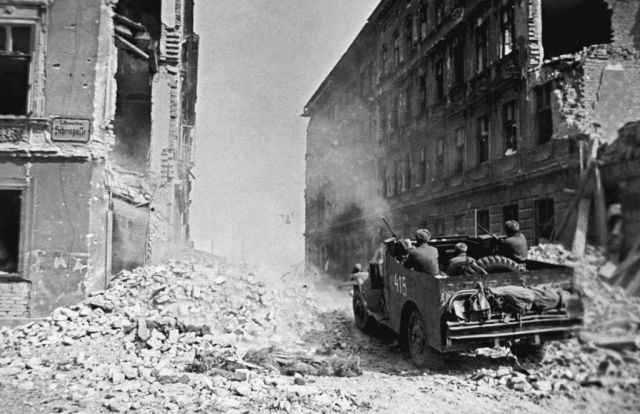
An American-made Soviet M3A1 Scout Car, supplied under Lend-lease, drives along a destroyed Vienna street. Photo: Evgeny Khaldei
This is how the idea of an infantry fighting vehicle (BMP) appears, capable of protecting the crew and passengers from small arms and damaging WMD factors, possessing high firepower, including against tanks, and sufficient mobility. With the advent of such a machine, the tactics of using motorized rifle units changed, which now depended less on tank support. And if the BMP had the opportunity to airdrop and overcome water obstacles, then it became an almost universal means.
The "penny" protects the infantry
At the end of the 1960s, Soviet military and engineers actively studied the world experience of armored personnel carriers and formed a technical task for a new type of equipment. Since the BMP was planned to be built en masse, one of the important conditions was its economy. The optimal capacity was considered to be 7-10 people, plus a crew consisting of a driver and an operator of stationary weapons. It was supposed to be possible to fight from a car. Much attention was paid to the armament of the BMP.
The Likhachev Plant, Volgograd Tractor Plant, Kurganmashzavod and Chelyabinsk Tractor Plant took part in the competition. The work of the latter won in the end, later becoming the famous BMP-1, adopted in 1966 and influenced the further development of armored vehicles on a global scale. It was its layout that became classic for cars of this class, and similar models appeared abroad only five years later.
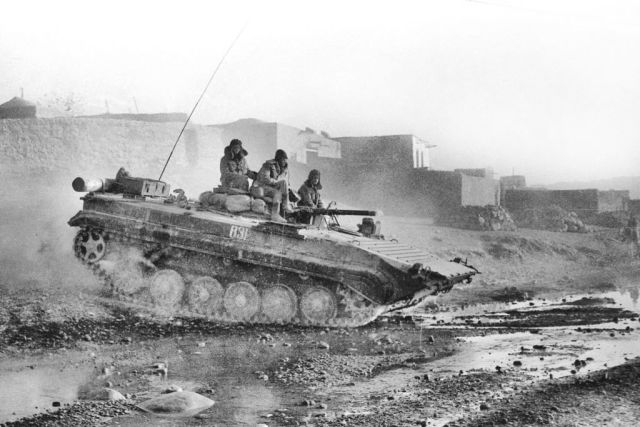
The main weapon of the BMP-1 was a smoothbore semi-automatic gun 2A28 "Thunder" of 73 mm caliber. A 7.62 mm PKT machine gun was paired with it, and a Baby ATGM was installed on the gun barrel. Thus, the BMP-1 operator could hit various types of targets: from manpower to almost any tank of those years. And the most widespread combat use of the machine was during the war in Afghanistan.
The unique "Penny", as it was nicknamed in the army, is still in service in Russia and other countries, despite the fact that individual copies are more than 40 years old. The BMP-1 was produced in Poland, Czechoslovakia, China, and India. From 1966 to 1983, more than 20 thousand units were produced. And the number of modifications, upgrades and other machines created on its basis is incalculable.
"Shaitan-arba" from Kurgan
The success of the new combat unit was consolidated by the BMP-2 adopted in 1980. It was also widely used in the conflict in Afghanistan, terrifying the enemy, for which the Mujahideen called it nothing but "Shaitan arba".
The Kurganmashzavod, which had been producing the BMP-1 in large series since 1966, was engaged in the development of the next generation. The designers were faced with the task of increasing the power of the weapon, since the protection of tanks had evolved by this time, and adding protective properties to the car itself. And all this had to be done as soon as possible.
Photo: Ministry of Defense of the Russian Federation
In the BMP-2, a two-seat turret appeared, in which, in addition to the gunner operator, the squad commander was now placed, who received the maximum view. A new car was armed with a 30-mm automatic cannon paired with a 7.62-mm machine gun, and the ineffective "Baby" was replaced with a Fagot ATGM. The new gun was developed by V.P. Gryazev from the Tula Instrument Design Bureau in just six months, taking his aviation developments as a basis. The automatic cannon was first installed on cars of this class.
And a few words about why the car was so successful during the Afghan conflict. Its paired installation has a maximum elevation angle of 75 degrees, the declination angle is 5 degrees, and the "dead zone" is only 22 m ahead of the machine body. Because of the high angle of ascent, the cannon could shoot at the mountains, where the Mujahideen set up ambushes and firing points to break up our columns.
The BMP-2 turned out to be effective, easy to operate and train, and proved to be excellent in combat operations. It has been supplied to dozens of countries and is still in service today.
Generation "3" and "3+"
The appearance of a new weapon from a potential enemy and the development of military science in general already in the late 1970s required the creation of the next generation of infantry fighting vehicles. In order to form a reserve for the future, it was necessary to significantly increase all the main characteristics of the machine − firepower, security and mobility. Therefore, the development of the third generation began even when the BMP-2 was just being tested.
The BMP-3 was the result of many years of work of the Kurganmashzavod in this direction. According to the new task, it was necessary to increase the armor protection so that the car could withstand the latest NATO weapons and at the same time maintain buoyancy. To do this, the layout had to be changed: the traditional front arrangement of the engine and transmission compartment for the BMP was replaced by the aft one - according to the "tank" scheme.
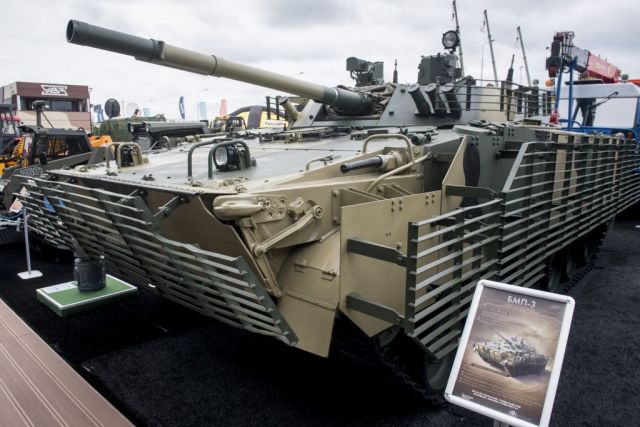
Photo: Anton Tushin
The UTD-29 diesel powerplant was developed especially for the BMP-3. And since the 1980s, a semi-automatic transmission has been used on the BMP-3 for the first time in the country for such machines. To increase the survivability of the new machine, a special alloy was developed − armored aluminum ABT-102, for the production of which a whole plant was opened.
The combined armament in one tower block consists of a 100-mm launcher, a 30-mm cannon and a 7.62-mm machine gun. The rocket launcher and cannon were developed by the same Vasily Gryazev from the Instrument Design Bureau. For the first time in the world, an automated fire control system was used on the BMP, which solved the task of shooting on the move.
The BMP-3 is the only infantry fighting vehicle that is equipped with active protection systems today. The task of the machine's operation in the conditions of the use of weapons of mass destruction was also solved − the BMP-3 has a sealed housing and a special ventilation unit.
As a result, the BMP-3 turned out to be a very balanced machine in all the most important parameters: fast, protected and well armed. In the 1990s, when the state defense order in the country fell significantly, it was the BMP-3 that kept the Kurganmashzavod afloat: the high quality of the machine ensured stable orders from foreign buyers. Export vehicles have strengthened the armies of a dozen countries. About 600 units were delivered in the UAE alone. According to the set of characteristics of the BMP-3, adopted back in 1987, there are still no competitors in the world.
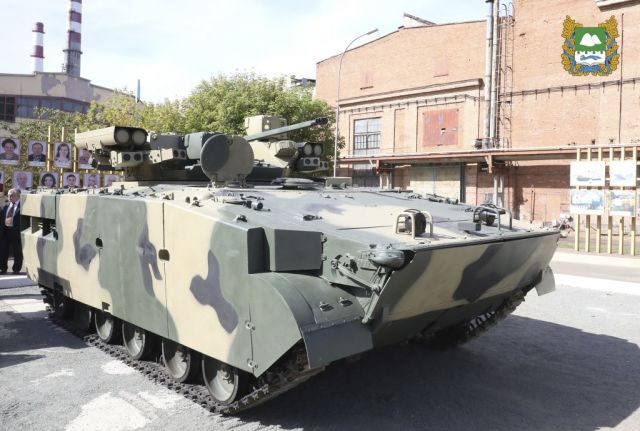
BMP "Manul". Photo: Government of the Kurgan region
In parallel with the deliveries of the machine to the Ministry of Defense of the Russian Federation, Kurganmashzavod continues to work on improving the tactical and technical characteristics of the product. In 2020, Kurgan residents presented a variant of the Manul BMP, which can be called transitional to the fourth generation. The car will be equipped with a more powerful UTD-32T engine located in the front. Manul will become a universal platform for creating equipment for various purposes, including infantry fighting vehicles for the Marine Corps. Work on a new generation of infantry fighting vehicles is being carried out taking into account the experience of using armored vehicles during the SVO in Ukraine.
